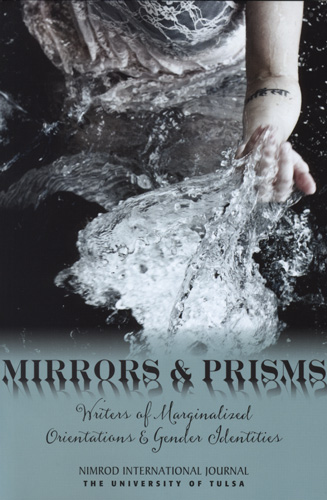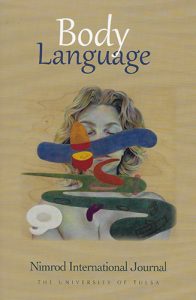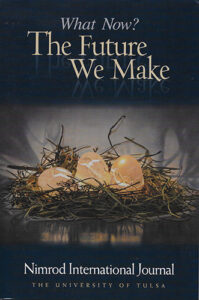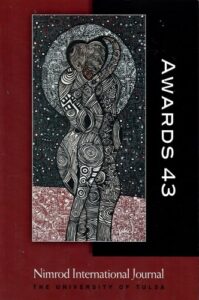Nimrod International Journal – Spring/Summer 2016
Nimrod International Journal has a history of devoting issues to underrepresented voices; Mirrors and Prisms continues this work, featuring only writers of marginalized sexual orientations and gender identities. But queer authors does not always mean queer subject matter. Editor Elis O’Neal states, “In this issue, you’ll find work on all subjects [ . . . ] we wanted to honor the breadth and depth of writing by our contributors, rather than limit their writing to a single aspect of their lives.” Nimrod takes a person-first approach to queer authorship.
Nimrod International Journal has a history of devoting issues to underrepresented voices; Mirrors and Prisms continues this work, featuring only writers of marginalized sexual orientations and gender identities. But queer authors does not always mean queer subject matter. Editor Elis O’Neal states, “In this issue, you’ll find work on all subjects [ . . . ] we wanted to honor the breadth and depth of writing by our contributors, rather than limit their writing to a single aspect of their lives.” Nimrod takes a person-first approach to queer authorship.
Bonnie J. Morris tackles the dual nature of being a queer writer in her essay, “Writing in Women’s Bars.” Her essay is both a personal account of keeping a journal through the gay liberation movement of the 1980’s through today, as well as how that journal was a political and historical action. Publicly writing in queer spaces was necessary to document queer experiences, yet threatened safety and anonymity. But someone had to record the stories of queer people: it was a way to pass down history. Morris begins her piece quoting the journal of Anais Nin, a queer woman writing about her experiences in the 1930s. It was Nin who inspired Morris to “go beyond mere personal musings in my own journal [ . . . ] I would [ . . . ] challenge homophobia with my fountain pen.” Starting with Nin, Morris traces the normalization and politicization of queer writing culture through the decades.
The poem “Thimble” by Kate Lynn Hibbard says nothing about queerness. She writes about Native American culture and the history of educating Native Americans in “Indian Schools.” The Native American speaker of the poem learns how to sew with a thimble. This narration is interrupted by quotes from The Chilocco Indian School’s Uniform Course of Study. Hibbard distinguishes this white, authoritative voice with stiff language, “All civilized nations have obtained their culture through the work of the hand / assisting the development of the brain.” This is prose transplanted into poetry. The Native American speaker is more creative with language and line breaks. Hibbard does not capitalize the start of each line and the language is more conversational, “and I couldn’t figure out what to do / with my fingers.” Hibbard’s poem does not need to address queer issues in order to record conflict between a normative and culture deemed “other.”
Shelley Ettinger’s story “Ginny Calabrese” fictionalizes the historical rape-murder of Kitty Genovese, the woman who was stabbed to death outside of her NYC apartment in 1964 as bystanders watched from their windows and did nothing. Ettinger could have written an essay on the real murder of Genovese, but instead uses the lens of fiction to make this a personal story, searing in emotional intensity and ultimately hopeful. Lillian, who is Ginny’s lover and childhood best friend, narrates as an old woman, fifty years after Ginny’s murder. Ettinger further personalizes the story through second person point of view, “Ginny, you’d never believe it.” You are Ginny. It is your death and your intimate relationship with Lillian that is cut short. The story further stands out by defying fictional convention: nothing happens. Lillian sits in an NYC bar late at night and watches a gay couple unashamedly walk by holding hands. The story begins and ends in the same scene in this bar. The movement of the piece is Lillian’s character development: her self-awareness turned forgiveness, her forgiveness turned hope. Throughout, she demands that Ginny be remembered not as a symbol or an academic study but as “A woman, who laughed sang spit drank, gristly and tenderhearted.”
Ettinger digs at the heart of Nimrod’s publication of queer authors: queer people aren’t poster children or symbols of a movement, but people. And people, as Lillian reminds us, have compassion: “Please, fellow Earthlings [ . . . ] Do not turn away from a person in need [ . . . ] I think that when you do some part of your brain stops firing.” Ettinger’s story begs us to be compassionate.
Nimrod isn’t targeted to queer audiences, but to all audiences to stretch beyond their own experience. A journal of queer writers opens up the conversation about what writers who are queer have to say. This dialogue is so much greater than any attempt to encapsulate a singular queer experience.
[www.nimrod.utulsa.edu]




